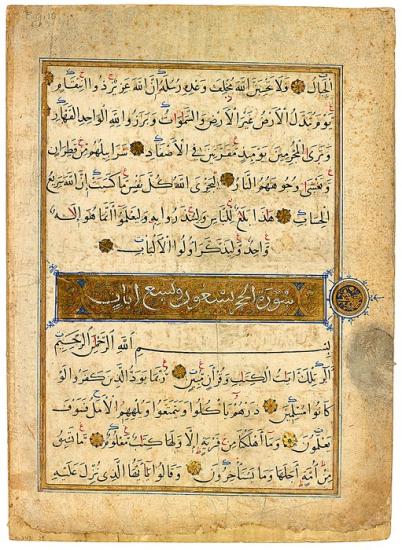Mamluk Qur˒an

Bifolio from a Mamluk Qur˒an
Bifolio from a Qur˒an, in Arabic
Bequest of Belle da Costa Greene, 1950
With the increased use of paper and the adoption of more upright scripts, the oblong format of the early vellum Qur˒ans gave way to a vertical one. On this page a large heading in white, cursive script marks the beginning of sura 15 (al-Ḥijr, or "The Rocky Tract").The heading is followed by the usual bismillah (call to piety), and the sura text begins on the next line. The sura is in naskh script with vocalizations and diacriticals in black. There are reading marks in red and blue, and rosettes mark the ends of verses.
The Qur˒an, the Holy Book of Islam
From a monumental volume used in an Istanbul mosque to a miniature Persian version that served as a talisman, this section features examples of illuminated pages from the holy book of Islam. The Qur˒an (to recite) represents the codification of the words of God that were revealed and transmitted through the angel Gabriel to the prophet Muḥammad (ca. 570–632) over a period of twenty-three years. The visions began in 610 in a cave on Mount Hira near Mecca, his birthplace, and continued after his 622 flight to Medina, until his death. His flight—the Hijra—marks the beginning of the Islamic calendar.
The revelations were arranged into 114 suras (chapters), each named after its theme. The first and shortest ones, at the end of the book, from the Meccan period, establish Muḥammad as the final prophet in a line of monotheists, including Abraham and Jesus. The longest suras, placed at the beginning, are Medinan and deal more with social and political issues.
For centuries, Qur˒ans were written in Arabic, the language of transmission. After Muḥammad's death, his cousin ˓Alī and others compiled the revelations into a text. About twenty years later, under Uthman, the third caliph (644–656) succeeding Muḥammad, a standard version of the Qur˒an —essentially the one used today—was produced. Thereafter Islam (which means "surrender to God") spread from the Arabian Peninsula throughout the Middle East, to northern Africa and southern Spain, and eventually the world.